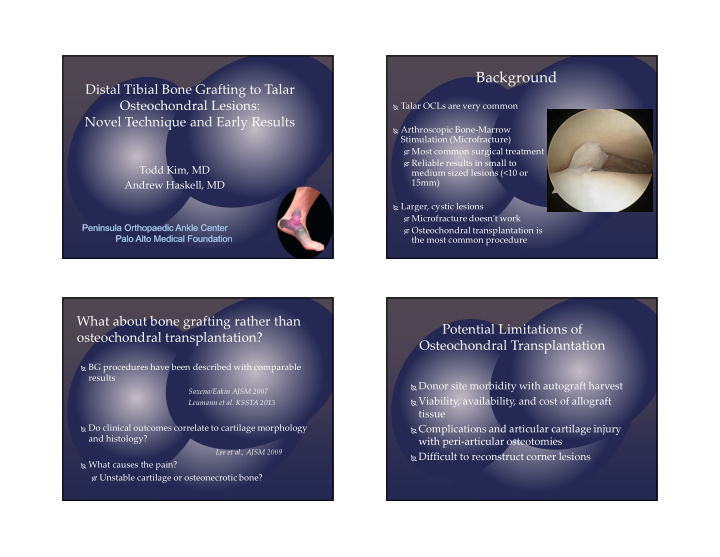



5/8/2014 Background Distal Tibial Bone Grafting to Talar Osteochondral Lesions: � Talar OCLs are very common Novel Technique and Early Results � Arthroscopic Bone-Marrow Stimulation (Microfracture) � Most common surgical treatment � Reliable results in small to Todd Kim, MD medium sized lesions (<10 or 15mm) Andrew Haskell, MD � Larger, cystic lesions � Microfracture doesn’t work � Osteochondral transplantation is the most common procedure What about bone grafting rather than Potential Limitations of osteochondral transplantation? Osteochondral Transplantation � BG procedures have been described with comparable results � Donor site morbidity with autograft harvest Saxena/Eakin AJSM 2007 � Viability, availability, and cost of allograft Leumann et al. KSSTA 2013 tissue � Do clinical outcomes correlate to cartilage morphology � Complications and articular cartilage injury and histology? with peri-articular osteotomies Lee et al., AJSM 2009 � Difficult to reconstruct corner lesions � What causes the pain? � Unstable cartilage or osteonecrotic bone? 1
5/8/2014 Oblique Placement of Bone Graft Potential Advantages of Distal Tibial Bone Grafting � Osteotomy is generally not necessary � Performed through same medial arthrotomy incision � Reaming removes all cystic/osteonecrotic bone � Stability of structural bone plug � Better coverage/fit for corner lesions because it is placed at an oblique angle � Minimal cost � Minimizes need for osteotomy � Advantageous for corner lesions Surgical Technique 2
5/8/2014 Clinical Series � 8 patients with minimum 6 months f/u (average 11.5 months) � Age 15-65, average 44 � All large medial talar dome OCLs with cystic component � 111mm 2 ; depth 7.6mm � All had failed nonoperative treatment Early Results Early Results � AOFAS score � pre-op 65.8 � post-op 89.9* (6 patients) � Foot Function Index � 18.4 � * improved using a paired T-test (p=0.02) � Mean final f/u 90, range 77-100 (8 patients) � 0 = no pain, best function � 100 = severe pain, worst function � 80-90 good; 90-100 excellent � Comparative outcomes � SF-12 � 52 PCS, 54 MCS � Microfracture: 88 (van Bergen et al. JBJS-Am 2013) � Scale 0-100, healthy norm 50 � Bone grafting: 93.4 (Saxena/Eakin AJSM 2007) � Autograft: 87 (Kennedy/Murawski Cartilage 2011) � Allograft: 83 (Raikin JBJS-Am 2009) 3
5/8/2014 Cost Early Results � Allograft talus: $6400 � VAS Pain � have to use it � 6.4 � 0.5 (4 patients) � 1.7/10 (8 patients) � Autograft OATS: � OATS kit $495 � VAS Satisfaction � OR time for harvest from knee � 8.9/10 (8 patients) � +/- cost of osteotomy fixation � 7/8 would have surgery again, 1 maybe � Particulated Juvenile Cartilage (De Novo™) : $4400 � have to use it � No complications; no re-operations � All patients returned to full duty work � DTBG procedure: OATS kit $495 Future Study Conclusions � Need larger numbers and longer term follow-up � DTBG procedure is a safe treatment for large talar dome OCLs � Prospective, randomized study � Can be performed without osteotomy and with � Imaging (MRI) or second-look arthroscopy to assess minimal cost relative to alternative procedures healing cartilage � Outcomes after short-term follow-up are � Is there a role for adjunctive cartilage procedures with DTBG (De Novo™- juvenile particulated allograft comparable to outcomes of microfracture, cartilage)? autograft-OAT, allograft OAT, and previously described bone grafting procedures 4
Recommend
More recommend